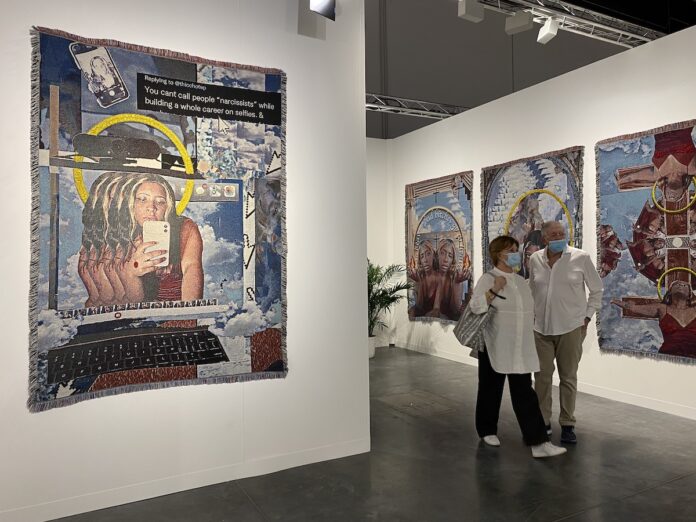At Art Basel Miami Beach’s opening on Tuesday, the show went on largely as normal, with blue-chip galleries selling their wares for top prices. Among the David Zwirners and Hauser & Wirths of the world, however, were a host of newcomers whose presence was made possible because the selection committee had altered some of its more exclusionary criteria for showing at at the fair.
This year, galleries are no longer required to have a physical space to participate. A rule about a gallery’s minimum age was also lowered. At a press conference, Marc Spiegler, Art Basel’s global director, explained that the move was intended to diversify Art Basel’s Miami Beach, which has historically had few Black-owned galleries and almost no exhibitors based in Africa. “We said, ‘Let’s take this hurdle away, because there are already enough hurdles anyway,’” Spiegler said.
The change in the selection committee’s rules didn’t radically transform the fair—only four out of the more than 250 exhibitors are from Africa this time around—but it did add some new variety to the mix.
One newcomer is First Floor Harare, one of the few commercial galleries in Zimbabwe focused on emerging artists. The gallery is showing new works by Troy Makaza, whose art blur the bounds between painting and sculpture, and resemble wall-hung cascades of woven forms. “Coming here allows us to engage with North American collectors, as well as other galleries and institutions, and to further the careers of the young artists we work with,” said Marcus Gora, who cofounded the gallery in 2009. “It’s been really great.”
Gora added that the addition of African dealers—not just African artists—is crucial. “At many fairs we go to, we find that there’s not many African gallerists taking part, compared to artists. On the business side, how do we thrive?” Showing at Art Basel could offer one way, he said.
Makaza’s work is being shown in Nova, a section of the fair devoted to art made during the past few years that tends toward the weird and the experimental. At the booth of New York’s Broadway gallery, another first-timer at Art Basel Miami Beach, curator Hans Ulrich Obrist could be seen admiring new films by Sky Hopinka. Elsewhere, at the booth for New York’s Company Gallery, there was a small survey of works by Ambera Wellmann, who has a semi-abstract painting of fleshy figures in the current New Museum Triennial.
Few booths in Nova attracted quite as many people as that organized by Kendra Jayne Patrick, the founder of an itinerant eponymous space that has staged shows in New York. The booth was mostly given over to tapestries by Qualeasha Wood, who makes images of Black women that draw on the visual language of the internet. Her figures are often ensconced in pop-up windows and surrounded by cursors. (One such work recently appeared on the cover of Art in America.)
Patrick said that the selection committee’s new rules effectively opened the door to emerging dealers like herself. “When I first got my itinerant program started, a friend asked me, ‘How are you going to represent artists if you don’t have a gallery?’ I remember saying, ‘Well, the bricks aren’t making the phone calls. The floor is seeing clients.’ I think it is exciting that Art Basel also doesn’t think the bricks make the calls and establish the relationships. It’s really forward-thinking of them to engage with a new generation of young dealers.”
























